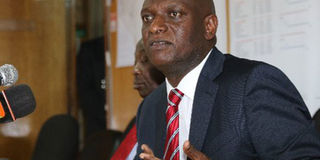State to light up all primary schools by Sunday

Energy Cabinet Secretary Charles Keter addresses a news conference at Nyayo House, Nairobi, on January 28, 2016. Mr Charles Keter said the government will not relent in its plan to connect power to schools across the country. PHOTO | NATION MEDIA GROUP
What you need to know:
- The Energy CS said the Sh7 billion budget for the National Public Lighting Programme will come from the exchequer, not donors as alleged by Cord principal Raila Odinga.
- State authorities have one year to light up streets and roads in 52 towns and cities across the country.
All 22,000 public primary schools must have electricity by Sunday, the Energy Cabinet Secretary has ordered.
Mr Charles Keter said Thursday the government will not relent in its plan to connect power to schools across the country as all required assets were available to implement the project within the deadline.
“The funds are available and, as far as I am concerned, it will be completed by Sunday. We are not just talking about connection but actual switch-on,” Mr Keter told journalists at his Nyayo House office.
He said a meeting would be held on Monday to confirm if the deadline was met.
The tight deadline has put the Rural Electrification Authority and Kenya Power under pressure.
“Let us cross the bridge when we get there because unless somebody is not doing his job … I don’t see why we won’t have powered these schools within the timelines,” Mr Keter said when asked about the fate of those tasked to oversee the plan should the deadline be missed.
The government is banking on the power project to drive its pet project of enhancing ICT uptake in schools.
The Jubilee administration has embarked on ambitious power projects that include lighting of streets across the country and connecting one million households to the grid this year.
A BRIGHT FUTURE
The Energy CS said the Sh7 billion budget for the National Public Lighting Programme will come from the exchequer, not donors as alleged by Cord principal Raila Odinga.
“This project ... is fully funded by the national government. No single donor is involved. County governments will bear the costs of managing the projects,” he said.
President Uhuru Kenyatta launched the expanded programme in Mombasa earlier this month.
Opposition leaders, who are currently camped at the coast, have criticised the much publicised launch, claiming it is a vote buying gimmick.
State authorities have one year to light up streets and roads in 52 towns and cities across the country.
The street lighting plan targets town centres and county roads in 52 regions across the country.
The project, which started in Nairobi, will now move to Kiambu, Kajiado, Kisii, Nakuru, Machakos, Mandera, Wajir, Laikipia, Bomet, Kisumu and Migori, among other towns.
Kenya Power, the Rural Electrification Authority, the Kenya National Highway Authority and the Kenya Urban Roads Authority are spearheading the project.





